| Home | Nature Weekly Index |
15 March 2020 | Moth Laying Eggs | Lymantria alexandrae |
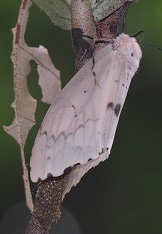
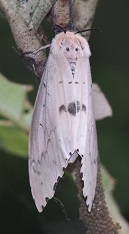 This was a very rare occasion where I witness a large moth laying hundreds of eggs but only realized it after
the fact. In January 2020, I was at one of my weekend photo session at a park when I saw a large white moth on
the top of a young tree. The location of the month was around 2 metres high which required me to stretch my
hands in order to snap some photos of the moth and at the same time worrying that it might flew off before I
got my pictures. Strangely, it was quite calm. I thought it was just another of those unknown moth that cross
my path.
This was a very rare occasion where I witness a large moth laying hundreds of eggs but only realized it after
the fact. In January 2020, I was at one of my weekend photo session at a park when I saw a large white moth on
the top of a young tree. The location of the month was around 2 metres high which required me to stretch my
hands in order to snap some photos of the moth and at the same time worrying that it might flew off before I
got my pictures. Strangely, it was quite calm. I thought it was just another of those unknown moth that cross
my path.
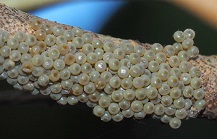
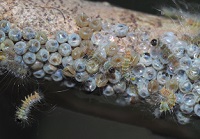 The excitement unfold when I viewed my photos from this field session back home. After enlarging the view of
the pictures, I saw large mass of eggs at the tail-end of the moth. With the discovery, I was quite eager to go
back to take some better pictures of the eggs. But, I had to wait for 4 days before my next off day. The
subsequent visit confirmed that the moth had indeed laid hundreds of eggs. The eggs were concentrated at 2
locations along the main vertical branch of the small tree.
The excitement unfold when I viewed my photos from this field session back home. After enlarging the view of
the pictures, I saw large mass of eggs at the tail-end of the moth. With the discovery, I was quite eager to go
back to take some better pictures of the eggs. But, I had to wait for 4 days before my next off day. The
subsequent visit confirmed that the moth had indeed laid hundreds of eggs. The eggs were concentrated at 2
locations along the main vertical branch of the small tree.
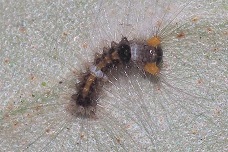 Since the park was not too far from my place, I re-visited the location again 2 days later hopping to see the
caterpillars but there was none. The eggs were still intact though darken. The hatching finally took place
another 2 days later. The total duration from egg to caterpillar was 8 days. When I visited again after 4 days,
there were only 5 caterpillars left on the treelet.
Since the park was not too far from my place, I re-visited the location again 2 days later hopping to see the
caterpillars but there was none. The eggs were still intact though darken. The hatching finally took place
another 2 days later. The total duration from egg to caterpillar was 8 days. When I visited again after 4 days,
there were only 5 caterpillars left on the treelet.
The scientific name of the moth should be Lymantria alexandrae, a kind of Gipsy Moth. A more complete set of pictures are available in the Lymantria alexandrae page in my website.
The treelet that the moth laid its eggs was Heritiera littoralis (Dungun). There were several of these trees in the park but I doubt they were the native resident. Instead, they were likely to be planted by Nparks a few years back. This particular treelet where the moth was found was not in its best condition compared to similar trees in other locations. It was overshadowed by taller trees and with relatively few leaves left. The very few leaves on it were incomplete, being eaten by different creatures over time. However, this tree was unlikely to be the host plant of the caterpillars since none of them was seen feeding on the leaves.